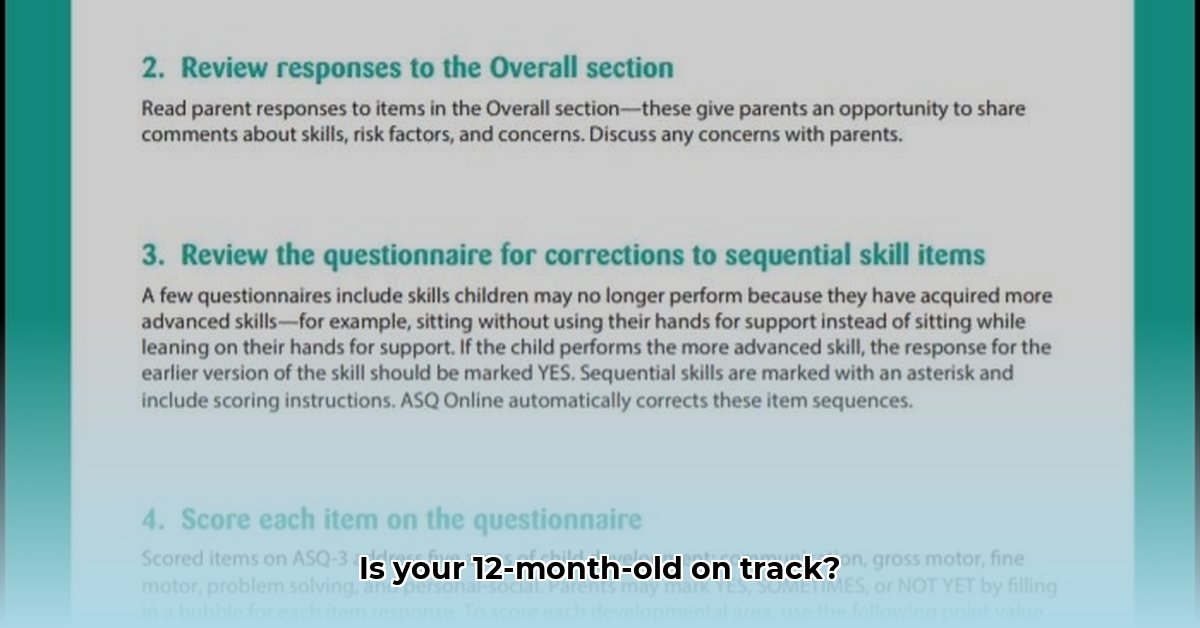Is your little one approaching their first birthday? It’s an exciting time filled with new discoveries! The 12-month Ages & Stages Questionnaire (ASQ) can help you understand your baby’s development and identify any areas where they might benefit from extra support. This comprehensive guide will walk you through using the ASQ, interpreting the results, and understanding typical 12-month milestones.
Understanding the 12-Month ASQ
What is the ASQ?
The 12-month ASQ is a simple questionnaire that acts as a developmental checklist. It provides a snapshot of your child’s progress in key areas like communication, gross motor skills (crawling, walking), fine motor skills (grasping), problem-solving, and personal-social interactions. It’s important to note that the ASQ is a screening tool, not a diagnostic test. It helps identify areas where further evaluation may be beneficial.
Why Use the ASQ?
Early detection of potential developmental differences can be incredibly valuable. The 12-month ASQ helps pinpoint areas where your baby might need additional support, allowing for early intervention if needed. Research suggests that early intervention during these formative months can significantly impact a child’s developmental trajectory.
Administering the 12-Month ASQ
Step-by-Step Guide
-
Gather Your Materials: You’ll need the 12-month ASQ-3 questionnaire, the scoring sheet, and a pen or pencil.
-
Set the Stage: Choose a comfortable and familiar environment where your child can play freely.
-
Review the Instructions: Familiarize yourself with the specific guidelines for each question.
-
Observe and Interact: Engage your child in play and observe their natural behavior. Avoid directing their activities or “testing” them.
-
Involve Caregivers: Gather input from other primary caregivers who can provide additional insights.
-
Answer the Questions: Mark “yes,” “sometimes,” or “not yet” based on your observations. Remember, there are no right or wrong answers; the goal is to accurately represent your child’s current abilities.
Scoring and Interpreting the ASQ
Calculating the Scores
Each “yes” answer typically receives 10 points, “sometimes” receives 5, and “not yet” receives 0. Add up the points for each developmental area.
Understanding the Results
Each area has a cutoff score. Scores below the cutoff suggest further evaluation may be beneficial. Discuss the results with your pediatrician, who can provide personalized recommendations based on your child’s individual needs.
Example Scoring Table (Refer to your ASQ-3 booklet for the official cutoff scores):
| Area | Example Cutoff Score |
|---|---|
| Communication | 40 |
| Gross Motor | 50 |
| Fine Motor | 35 |
| Problem Solving | 45 |
| Personal-Social | 55 |
“Sometimes” Responses
“Sometimes” answers are valuable indicators of emerging skills. They show that your child is on their way to mastering these abilities.
Typical 12-Month Milestones
Every child develops at their own pace. These are general guidelines, and variations are normal. Ongoing research continues to expand our understanding of child development, and these milestones may be subject to change.
Gross Motor
- Pulling to stand
- Cruising along furniture
- Walking with or without assistance
- Climbing stairs with help (always supervise!)
Fine Motor
- Using the pincer grasp (thumb and forefinger)
- Feeding themselves with fingers
- Holding and drinking from a cup
- Turning pages in a book (may be several at a time)
Communication
- Saying “mama” and “dada” and possibly other simple words
- Understanding simple instructions (e.g., “wave bye-bye”)
- Pointing to desired objects
- Babbling with varied intonation
Cognitive
- Exploring objects through different actions (shaking, banging, throwing)
- Finding hidden objects (demonstrates object permanence)
Social/Emotional
- Showing affection (cuddles, smiles)
- May exhibit stranger anxiety
- May experience separation anxiety
- Expressing a range of emotions
Milestone Table:
| Developmental Area | Milestone Examples |
|---|---|
| Gross Motor | Walks independently or with assistance, pulls to stand, cruises furniture |
| Fine Motor | Uses pincer grasp, feeds self with fingers, holds and drinks from a cup |
| Language/Communication | Says simple words, understands simple instructions, points to objects, babbles |
| Cognitive | Explores objects, finds hidden objects |
| Social/Emotional | Shows affection, may show stranger/separation anxiety, expresses emotions |
Next Steps and Resources
What if My Child’s Score is Below the Cutoff?
Don’t be alarmed. It simply suggests that further investigation may be helpful. Discuss the results with your pediatrician, who can offer guidance and connect you with appropriate resources if needed.
Early Intervention
Early intervention services can provide specialized support to help your child reach their full potential. These services may include therapies, individualized learning plans, and support for families. Current research suggests that the efficacy of various early intervention methods is still being explored, and new approaches are constantly being developed.
Pediatrician as Your Partner
Your pediatrician is your primary resource for information and support. They can address any concerns you may have, provide additional assessments, and recommend next steps.
Reputable Online Resources
- American Academy of Pediatrics (HealthyChildren.org)
- Centers for Disease Control and Prevention (CDC.gov) – Child Development
Remember, the ASQ is just one tool to help you understand your child’s development. Trust your instincts, celebrate every milestone, and enjoy this incredible journey!
- Adult Bento Meal Ideas for Delicious, Easy, and Healthy Lunches - December 24, 2025
- Adult Bento Box Ideas for Delicious and Easy Lunches - December 23, 2025
- Healthy Bento Lunch Ideas for Adults to Enjoy Lunch Again - December 22, 2025










